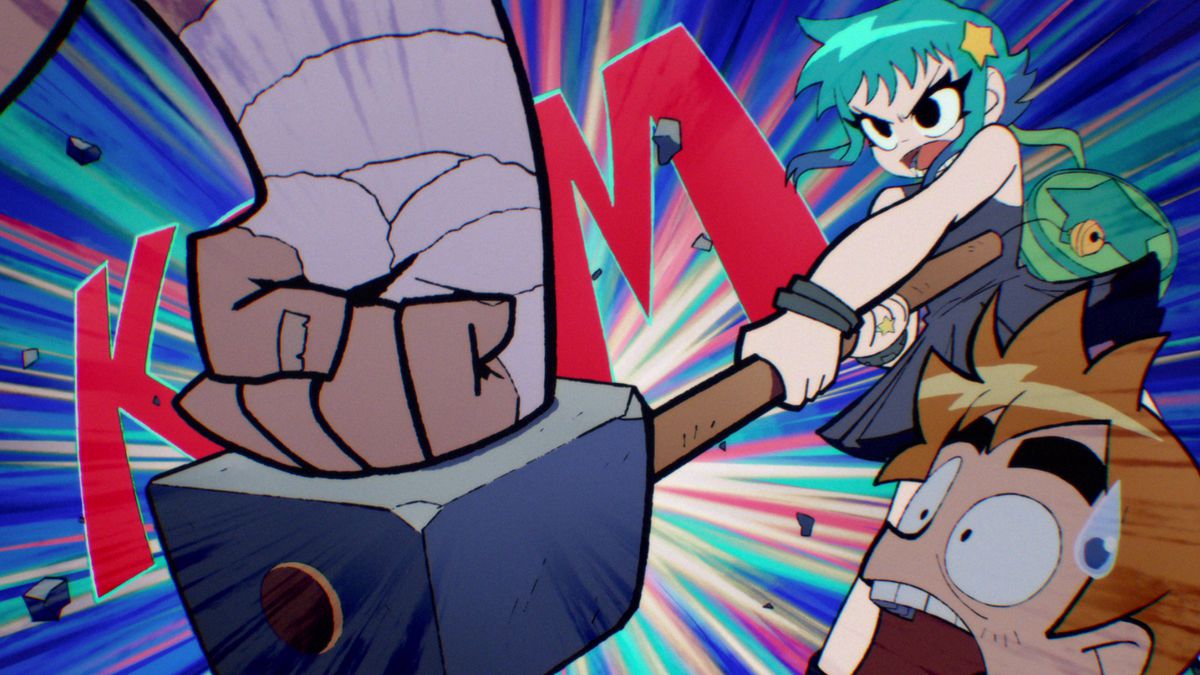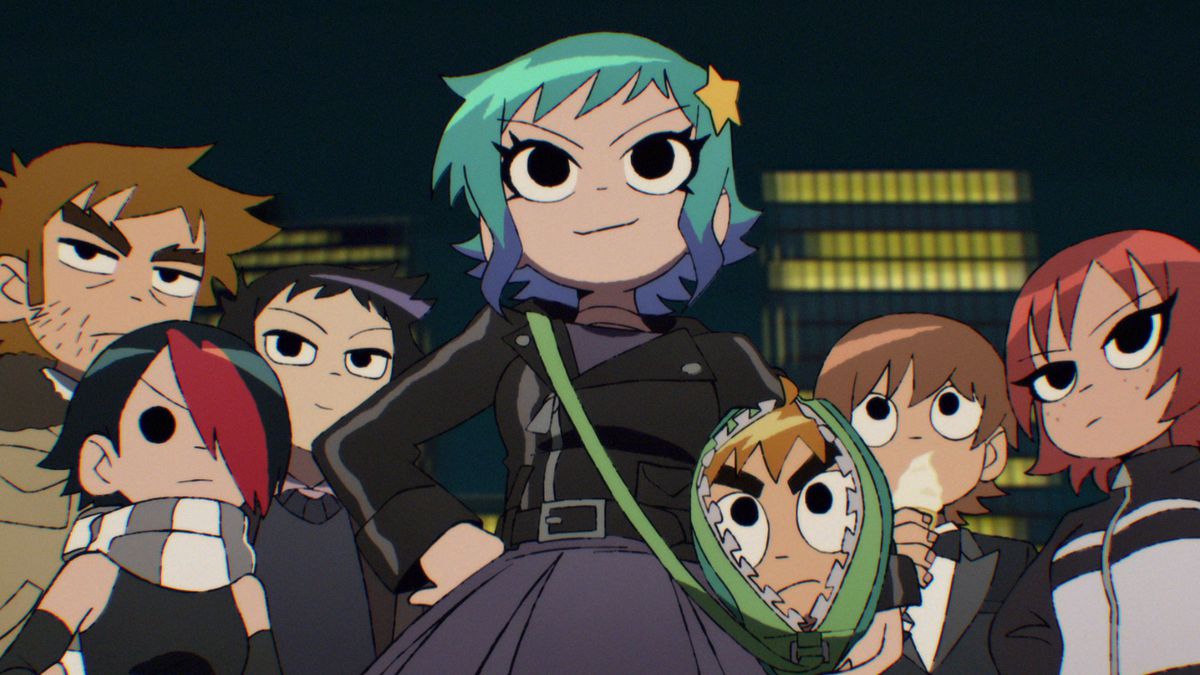‘I don’t want to revisit myself at 25’: The story behind Netflix’s bold Scott Pilgrim anime
Most people now know the secret behind it Scott Pilgrim leaves: Scott Pilgrim — well, he leaves. He’s gone for most of the story, leaving the players as we know them to pick up the pieces and figure out what happened to him. What happens to them in his absence is usually a total reversal of what we’re used to: think Gideon is introducing Lucas to the slowburn anime he’s been watching for a while (or maybe just a few days).
Bryan Lee O’Malley, who wrote the original comic and co-created the Netflix anime reboot with BenDavid Grabinski, knows audiences have come to expect this kind of remake. “I mean, it’s up in the air, right? We’re all seeing remakes and reboots of everything,” says O’Malley.
When Scott Pilgrim leaves was in development, he says he and the team looked at everything new in this spirit The Matrix Resurrections Unpleasant Spider-Man: No way home. But just as often he looked elsewhere for inspiration – Dragon Ball Z, Cowboy Bebop, Keep your hands off Eizouken!or even Elden Ring. But none of these were really the main catalyst, not even something like Evangelion, which he calls “a good comparison, but not necessarily an influence.”
The real reason O’Malley wanted to make this story was simply: it was the only way he could revisit the world of Scott Pilgrim.
(Ed. remark: This interview has been edited and condensed for clarity.)
Polygon: First off, I’m curious about how you got justice from Matthew Patel, the lowest-ranked evil ex.
Image: Netflix
Bryan Lee O’Malley: Our first idea was to kind of take Scott Pilgrim out of the picture after the first episode. And that of course led to the process of: What happens to Matthew? What does Matthew get? And what do the other exes think of it? So yeah, it really appealed to me right away, and to say: Oh, then Matthew should win, and Matthew should be in charge. Because we go through all these different reversals of fortune; so someone goes from top to bottom, and someone has to go from bottom to top. And yes, giving Matthew some sort of flowers was so nice.
Were there any characters in particular – like Matthew, or just in general – that you were most excited about, such as: Okay, if we open up this world without Scott in it, what can you do?
I was excited to take on all the exes; that was one of the biggest draws for me to revisit Scott Pilgrim, was just – I felt like I gave them a little short shrift in the books. I was making it up as I went along, and I was locked into Scott’s perspective. And I was younger and didn’t really know much about people like that! I certainly didn’t know anything about movie stars or rock stars, I didn’t really know the details of how they lived; I just saw them in magazines, or whatever, or in movies.
So now I’ve lived a little longer, been in LA for a long time and met a lot of different types of people. And I think that just leads to giving these characters a little more pathos, a little more depth and nuance – and pathos also in the sense of, like: pathetic; they are also losers. And I always really liked that.
One of the things BenDavid told me was that you were approached to adapt this, and you struggled with: Well, I’ve changed since I did this story, what does that mean? And I’m curious what you were really thinking about when you were approached about this series that so many people love and so many people cherish, and it seems different to you now.
Well, I mean, that’s the initial fear. Netflix and our producers, Jared (LeBoff) and Edgar Wright, had approached me, we had talked about it a little bit – making a series – and they initially wanted to do it much more like the books. And for me, that made me recoil a little bit. Like I don’t necessarily want to revisit myself at 25. And it’s all there! It’s all on the page. So why would I want to relive that? Why would I want to perfect something that was so messy; it just seems like an impossible task.
Because the messiness is such a part of it. It’s part of the joy of it: it’s messy, it’s complicated. It is irreducible. So when I was faced with writing X number of TV episodes, I thought: how the fuck am I supposed to do that? I just had no idea, so it wasn’t until that dinner with BenDavid that we started spitballing a bit – not professionally; just joking (wondering), What can we do with these characters? And then a lot of those jokes that made us think: Oh, actually that would work. So, you know, the joke of ‘Scott dies at the end’ or ‘Matthew becomes the boss’ – that’s all become something that we can really work with.

Image: Netflix
At what point did it become clear to you that if we rethink this, and we take Scott out, and we give everyone space to be a little more themselves, a little more nuanced – at what point it became a little bit: Oh, maybe Scott is the bad guy?
Well, I mean, that’s certainly part of the initial discussion. That’s a perception. I don’t really see Scott as the bad guy. But nowadays – this is terrible to say in an interview – the perception, especially on Twitter and stuff, has changed over the last five years, where now it’s like, “He’s got a bad character!” “It’s a toxic relationship!” and all that kind of talk.
And I think all that stuff is WHERE. But I don’t think people in the 2000s didn’t think this was true. I think the younger generation, for example We discovered that Scott is evil. But you know, it says on the very first page that he’s dating a high school student; no one should think that is a good thing. I think in the 2000s I took it for granted that people would say: Oh, he’s terrible, but it’s funny. So now you have to be a little more explicit: it’s just the way our culture works, the way online works. For example, if you don’t condemn something outright, the lack of condemnation is seen as tacit approval.
So yeah, it was never a tacit approval. It was a tacit condemnation. But certainly in the show in the modern era, yeah, we have a scene where (we show) Scott, it’s not a good thing to date a high school student. So – throw them a bone?
I’m curious how you’ve interpolated and also synthesized a lot of the conversations that are happening around this property, because it feels like this show is so in conversation with them.
I’ve absorbed all those things over the years; I didn’t disappear after Scott Pilgrim was done. So in many ways I want it to feel like Scott Pilgrim is back from the dead. You thought it was gone, but it’s back. But not only is it back, as if it never left, it has also paid attention to you. It grew up with you.

Image: Netflix
And we had to target so many different audiences: someone like you, who read it a long time ago and has some kind of memory of it, of what it felt like. But also someone who read it for the first time last week, or someone who has just discovered the film, or someone who hasn’t seen it yet. So it was just this really complex but invigorating challenge: How do we make this feel fresh and layered – and hopefully disconcerting to some people who have been thinking about the book, but maybe not to this extent?
Were you surprised by your reaction when you revisited this and rephrased it in some way? Were there any characters that you felt sounded a little different or sat with you a little differently?
I don’t think I have a good memory of how it hit then. But it was really just a fun process, writing it and discovering these things and challenging ourselves to find new ways of doing everything.
I got to write the amazing scene where Knives and Kim sit down and play music together. And it’s not something I could have done in the comic, a) because it’s music. And just the logistical challenge of making that happen, and making it feel organic and real, was very satisfying. And then that final scene, which just magically played for me. It was cool to explore those things through collaborating with all these different artists and stuff. And that was the big new thing. It’s just letting other people in and letting them all have their own different kinds of love for the show. And it shows, I think.
Scott Pilgrim leaves is now streaming on Netflix.
